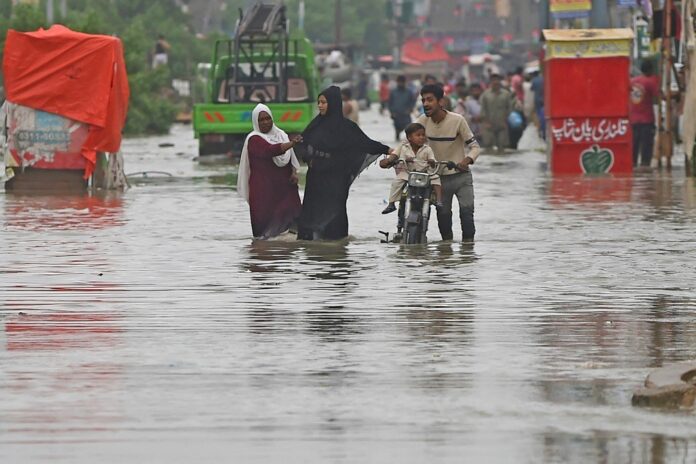KARACHI: Mohammed Danish Khan left home with his family to attend a dinner earlier this month when his motorbike skidded into a drain in unusually heavy rainfall, killing his wife and infant son.
“I didn’t know that rain was going to claim the lives of my family,” the 23-year-old carpenter in Karachi told Arab News. “I don’t want anyone to face the tragedy I have gone through.”
Only a week after the incident, the seaside Pakistani megapolis in Sindh province witnessed yet another cloudburst in which 15 people either drowned or died of electrocution.
According to National Disaster Management Authority data, 357 people have been killed across the country and 408 injured since the beginning of the season in mid-June.
Over a hundred casualties have been reported in Balochistan, the country’s impoverished southwestern province, while 93 people, including 47 children, also lost their lives in three monsoon spells that lashed Sindh in July.
Dr. Sardar Sarfaraz, chief meteorologist in Karachi, told Arab News the downpours across the country in the ongoing month had been about 200 percent heavier than the average, with the southern parts of Pakistan bearing the brunt of the rainy season.
“Sindh saw some very intense rainfall events in July,” he said. “Karachi, Badin, Sukkur and Padidan received the highest rainfall, which broke all previous records.”
Dr. Ghulam Rasul, a climate change expert and vice president of the Asia-Pacific region at the World Meteorological Organization, said climate change had made the monsoon highly erratic in terms of its onset, intensity and area of coverage.
“This year’s monsoon is among the special ones as its onset was 10 days earlier than its normal beginning in Pakistan,” he told Arab News. “It attained its peak in July, which normally occurs in August, and heavily penetrated monsoon shadow zones, including Balochistan and the high mountains of Khyber Pakhtunkhwa and Gilgit-Baltistan, where it usually does not reach.”
Extreme weather events are increasingly becoming the norm across the region, with its major cities remaining ill-equipped to handle them.
“Due to global warming, the frequency of such intense monsoons will increase,” Rasul said. “Climate change will also pose a challenge to policymakers regarding how best to manage heatwaves, droughts and floods, which will be occurring simultaneously.”
Pakistan has long ranked among the most climate-vulnerable countries, according to the Global Climate Risk Index. It is estimated to have lost nearly 10,000 lives to climate-related disasters and suffered losses amounting to $4 billion from extreme weather events between 1998 and 2018.
In August 2020, heavy rains killed 44 people in Karachi and urban flooding disrupted the lives of the city’s 15 million people.
Mashail Malik, assistant professor of government at Harvard University, who studies Karachi’s political landscape, links the tragedies with the growth of poor squatter settlements and slums.
“Aside from these failures in governance, another reason heavy rainfall is so devastating is simply because so much of the population lives in informal settlements — a reality that is often unavoidable in major urban centers in much of the global south,” she told Arab News.
The Sindh administration said it was trying to address the problem without creating greater challenges for the impoverished communities and has mobilized human resources and all necessary equipment to deal with the monsoon season this year.
Sindh Chief Minister Murad Ali Shah said in a written interview with Arab News. “We are working to reconstruct and rehabilitate the dilapidated infrastructure of Karachi that has worsened due to ill-conceived planning, illegal constructions, widespread encroachments.”
“We keep upgrading our preparedness and response systems to tackle the weather unpredictability and avert urban rain flooding,” he added.
“Although we do not contribute significantly to the global emissions that pollute the environment, Pakistan is one of the worst-affected countries due to climate change.”

